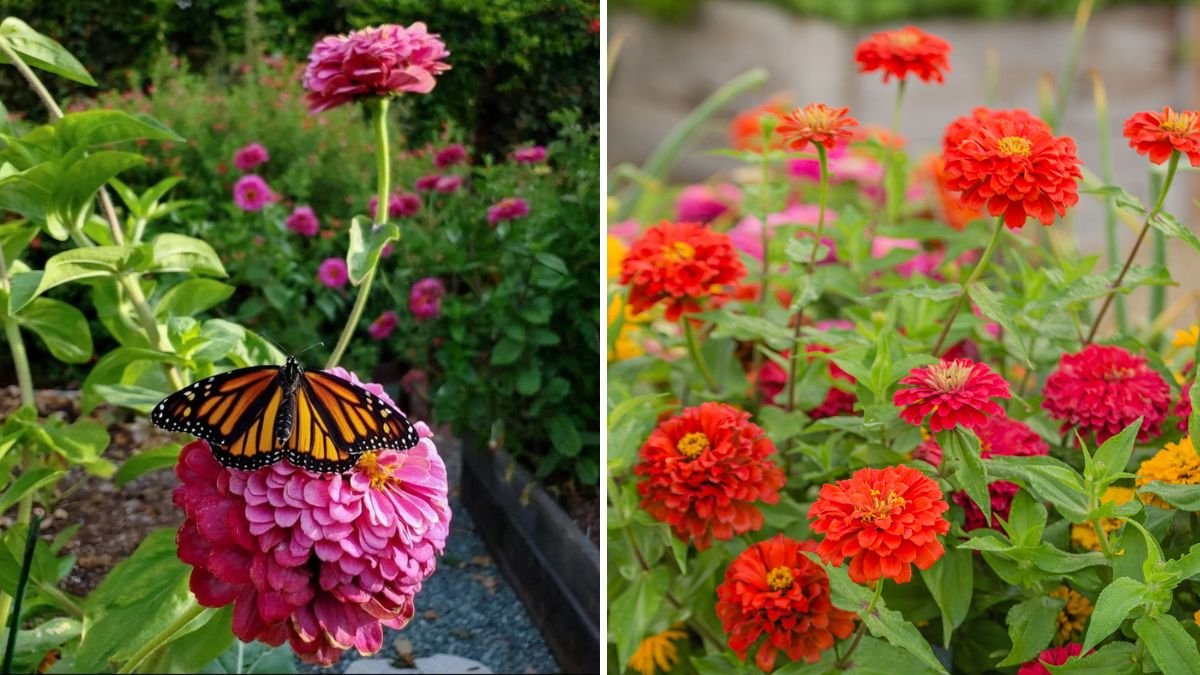Zinnias (Zinnia spp.) are a favorite among gardeners for their vivid colors, long-lasting blooms, and ability to attract butterflies and bees. They thrive in full sun, tolerate heat, and bloom throughout summer, making them a perfect addition to any pollinator-friendly garden. However, zinnias reach their full potential when paired with companion plants that attract and support pollinators. Growing the right companions not only enhances the garden’s beauty but also ensures that bees, butterflies, and hummingbirds thrive, promoting a healthy ecosystem.
In this article, we’ll explore 10 pollinator-friendly plants that pair beautifully with zinnias, why they’re ideal companions, and tips for creating a blooming, vibrant, and ecologically beneficial garden.
Why Companion Planting Matters for Zinnias
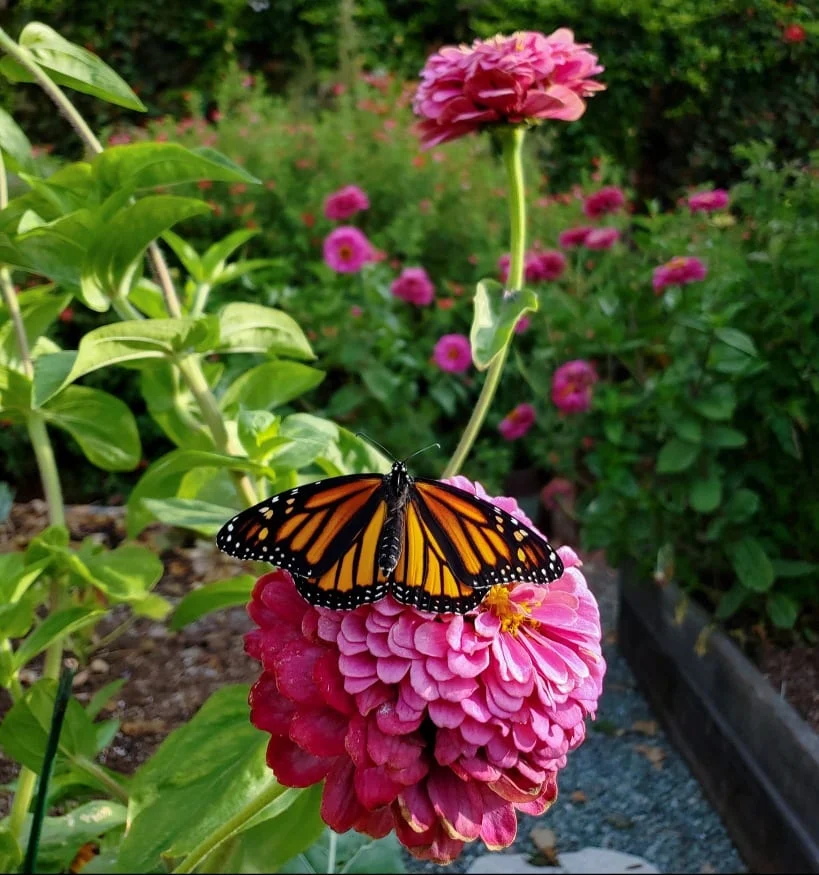
Companion planting is the practice of placing plants together that benefit each other’s growth, appearance, or pest resistance. For zinnias, companion planting with pollinator-friendly plants can:
- Increase pollination rates, resulting in more prolific and healthy blooms.
- Create a continuous display of color from spring through fall.
- Support beneficial insects that naturally control pests.
- Enhance the structural diversity and aesthetic appeal of your garden.
Zinnias prefer well-drained soil, full sun, and moderate watering, so the best companions share these growing conditions.
1. Sunflowers (Helianthus annuus)
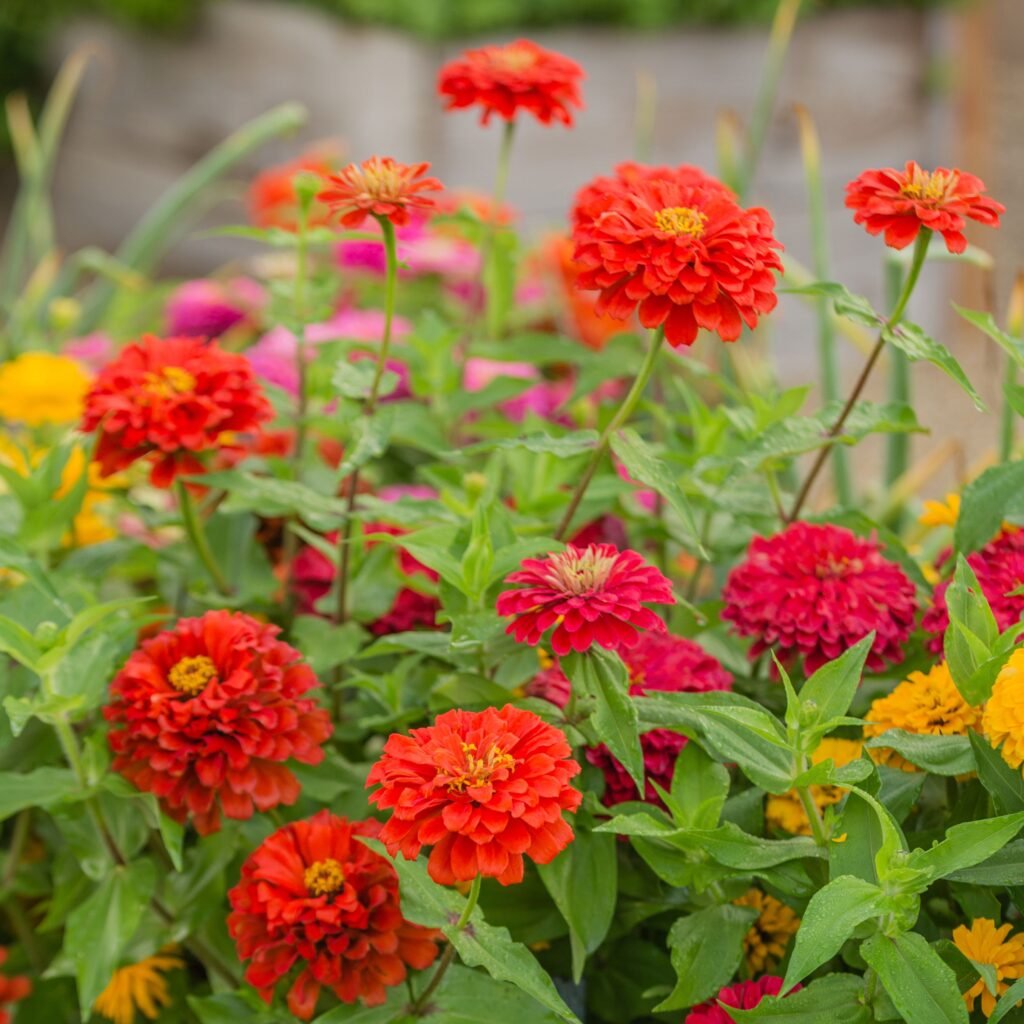
Sunflowers are tall, cheerful blooms that attract a wide variety of pollinators.
Why They Pair Well With Zinnias:
- Their large, bright flowers draw bees, butterflies, and hummingbirds to the garden.
- Provide vertical structure that contrasts nicely with shorter zinnias.
- Both thrive in full sun and heat, making care easy.
Planting Tips:
- Plant sunflowers behind zinnias for a layered garden effect.
- Choose dwarf varieties if space is limited to avoid overshadowing zinnias.
- Provide support for tall sunflower varieties to prevent lodging.
Expert Insight: Sunflowers enhance visual interest and pollinator attraction, complementing zinnias’ vibrant colors.
2. Coneflowers (Echinacea spp.)
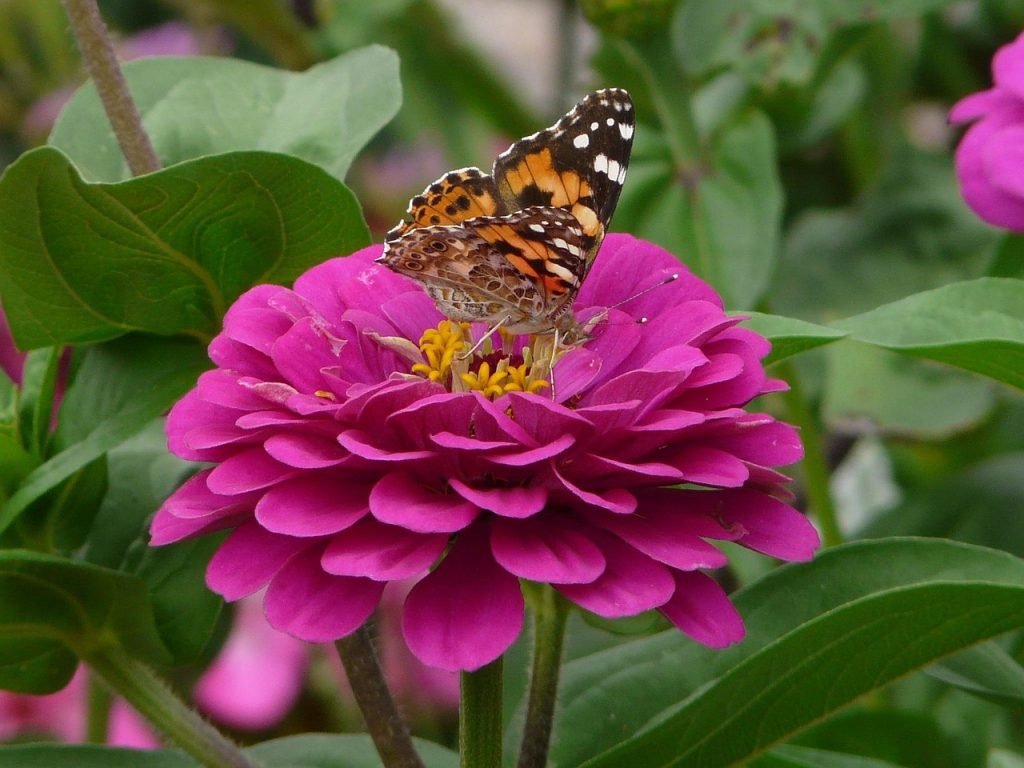
Coneflowers are hardy perennials with long-lasting blooms that attract bees and butterflies.
Why They Pair Well With Zinnias:
- Both are sun-loving plants that tolerate heat and dry soil.
- Their upright, daisy-like flowers contrast well with zinnias’ rounded blooms.
- Coneflowers’ nectar-rich flowers encourage pollinators to visit the entire garden.
Planting Tips:
- Space coneflowers at least 12–18 inches from zinnias to allow airflow.
- Choose complementary colors like purple, pink, or white for contrast.
- Deadhead spent blooms to encourage continued flowering.
Expert Insight: Coneflowers extend the pollinator-friendly garden season with their mid-to-late summer blooms.
3. Lavender (Lavandula spp.)
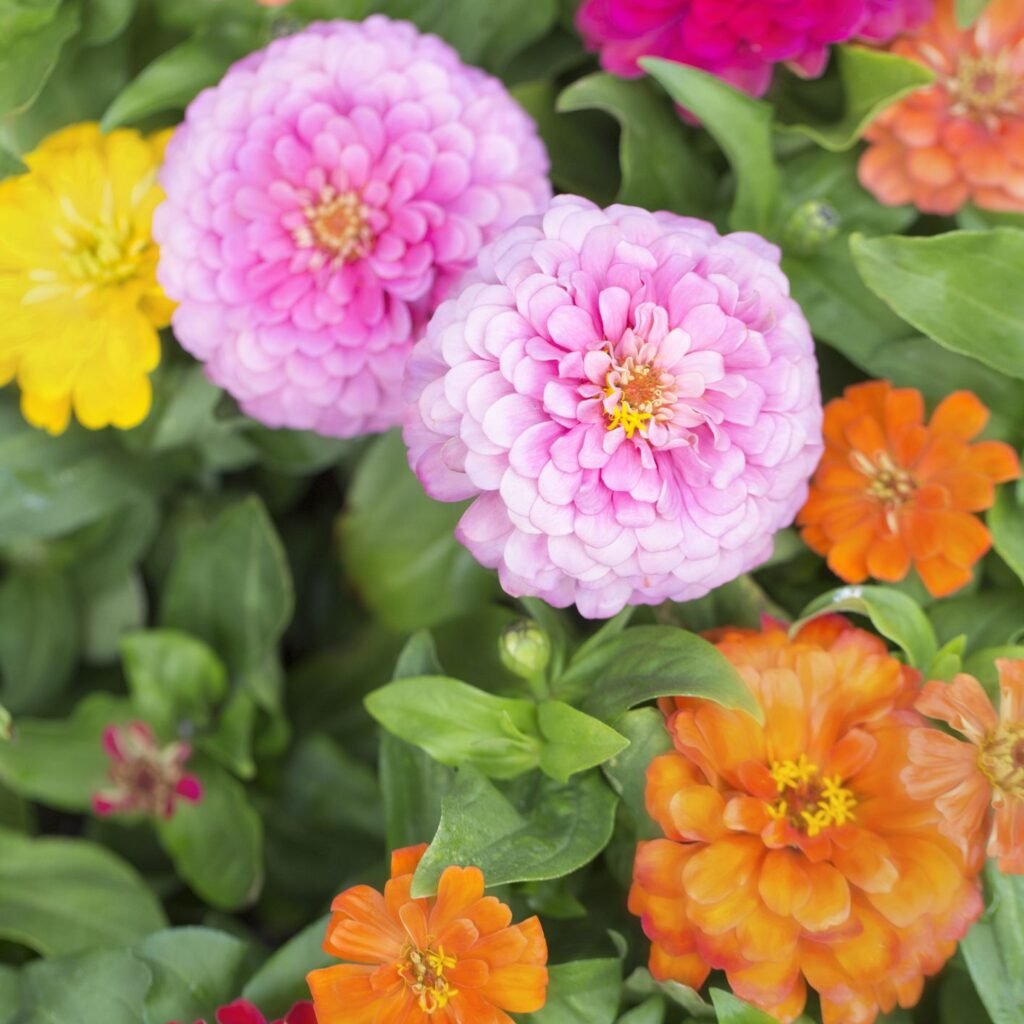
Lavender is a fragrant, drought-tolerant perennial that attracts bees and beneficial insects.
Why They Pair Well With Zinnias:
- Lavender’s aromatic flowers draw pollinators away from pests and towards zinnias.
- Its purple spikes complement the bright reds, oranges, and yellows of zinnias.
- Both plants thrive in well-drained soil and full sun.
Planting Tips:
- Plant lavender at the edges or corners of zinnia beds.
- Trim after flowering to maintain shape and encourage rebloom.
- Avoid overwatering, as both plants prefer slightly dry soil once established.
Expert Insight: Lavender enhances fragrance, visual appeal, and pollinator activity, making it an ideal zinnia companion.
4. Marigolds (Tagetes spp.)
Marigolds are easy-to-grow annuals that add bright pops of color and attract pollinators.
Why They Pair Well With Zinnias:
- Both bloom profusely during summer and thrive in full sun.
- Marigolds attract bees and butterflies, complementing zinnias’ pollinator draw.
- Their scent repels some pests, creating a healthier garden environment.
Planting Tips:
- Plant marigolds in clusters around zinnias for continuous color.
- Deadhead regularly to prolong flowering.
- Use dwarf or medium varieties to avoid overcrowding.
Expert Insight: Marigolds provide a colorful, pest-reducing companion that enhances zinnias’ growth and pollinator appeal.
5. Black-eyed Susans (Rudbeckia hirta)
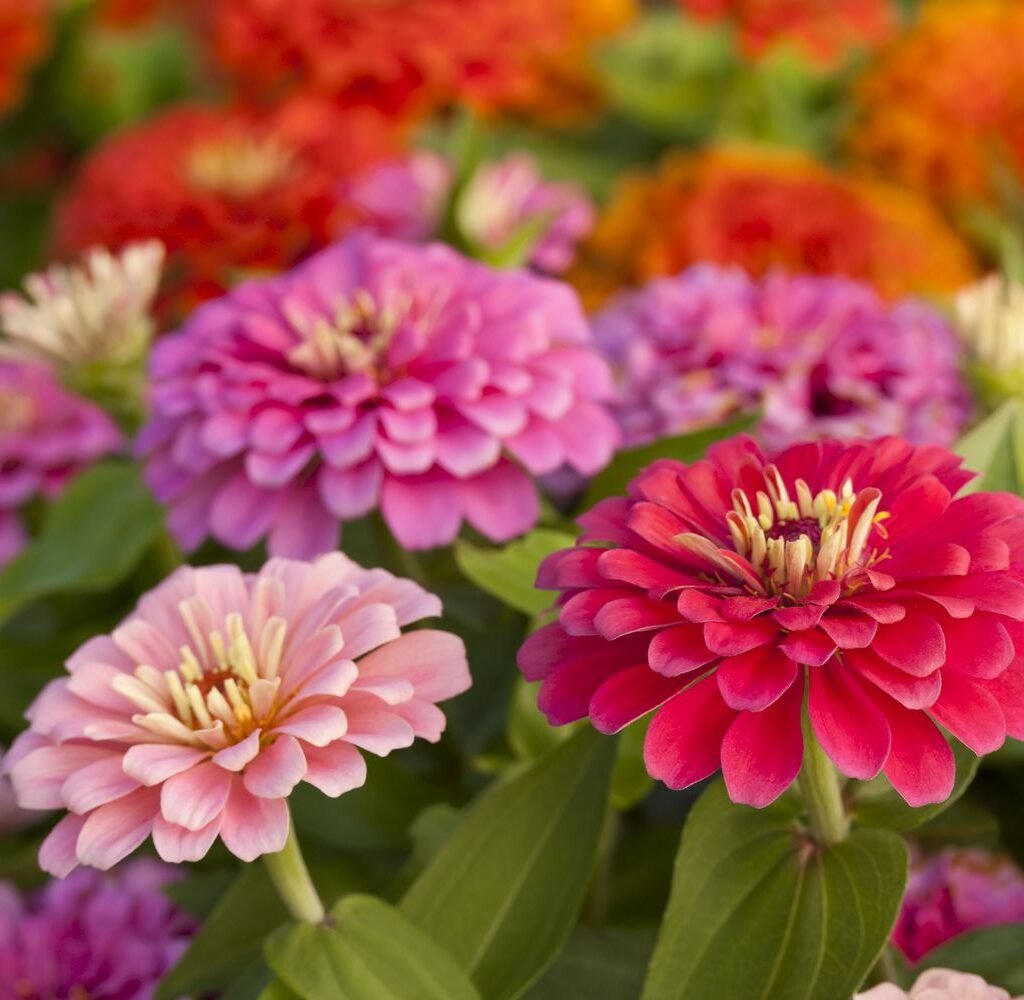
Black-eyed Susans are cheerful, drought-tolerant perennials that attract a wide range of pollinators.
Why They Pair Well With Zinnias:
- Their bold yellow petals contrast beautifully with zinnia colors.
- Nectar-rich flowers encourage bees, butterflies, and hummingbirds to visit.
- Both plants thrive in sunny, well-drained locations.
Planting Tips:
- Space plants at least 12 inches apart to allow airflow.
- Deadhead to extend bloom time.
- Combine with other summer perennials for a layered garden effect.
Expert Insight: Black-eyed Susans add height, texture, and continuous pollinator support, boosting zinnias’ productivity.
6. Salvia (Salvia spp.)
Salvia, or sage, is a tall, spiky perennial with nectar-rich blooms.
Why They Pair Well With Zinnias:
- Attracts bees, butterflies, and hummingbirds to the garden.
- Contrasts zinnias’ rounded flowers with vertical, colorful spikes.
- Heat and drought tolerant, making it low-maintenance alongside zinnias.
Planting Tips:
- Plant salvia behind or between zinnia clusters for layered height.
- Deadhead to encourage rebloom.
- Ensure full sun exposure for optimal flowering.
Expert Insight: Salvia’s nectar-rich blooms make it a magnet for pollinators, increasing zinnias’ visitation rates.
7. Cosmos (Cosmos bipinnatus)
Cosmos are airy, daisy-like annuals that attract pollinators and add movement to garden beds.
Why They Pair Well With Zinnias:
- Their delicate flowers contrast zinnias’ bold shapes while offering complementary color.
- Cosmos attract butterflies and bees, supporting the entire garden ecosystem.
- Both are drought-tolerant and bloom abundantly in summer.
Planting Tips:
- Sow seeds between zinnia clusters or along edges for continuous color.
- Support taller varieties if necessary to prevent lodging.
- Deadhead regularly to encourage more blooms.
Expert Insight: Cosmos provide light, airy texture and enhance the pollinator-friendly qualities of zinnia beds.
8. Bee Balm (Monarda spp.)
Bee balm is a perennial that attracts a variety of pollinators, especially bees and hummingbirds.
Why They Pair Well With Zinnias:
- Both plants thrive in full sun with well-drained soil.
- Bright, tubular flowers provide nectar-rich sources for pollinators.
- Adds vertical interest with its upright growth habit.
Planting Tips:
- Space plants 18–24 inches apart to allow airflow.
- Deadhead spent blooms to prolong flowering.
- Mulch to retain soil moisture and control weeds.
Expert Insight: Bee balm complements zinnias by extending bloom diversity and attracting essential pollinators.
9. Alyssum (Lobularia maritima)
Alyssum is a low-growing, fragrant annual that forms a dense carpet of blooms.
Why They Pair Well With Zinnias:
- Attracts bees, hoverflies, and beneficial insects, supporting zinnias’ growth.
- Provides groundcover that suppresses weeds and retains moisture.
- Fragrant blooms add sensory appeal to zinnia gardens.
Planting Tips:
- Plant alyssum around the base of zinnias for continuous blooms and fragrance.
- Trim lightly after flowering to encourage a second bloom.
- Combine with other low-growing companions for a layered garden effect.
Expert Insight: Alyssum enhances pollinator diversity and garden fullness, making zinnias flourish.
10. Snapdragons (Antirrhinum majus)
Snapdragons are vertical annuals with bright, tubular flowers that attract pollinators.
Why They Pair Well With Zinnias:
- Provide vertical contrast to zinnias’ mounded growth habit.
- Tubular flowers attract bees and hummingbirds.
- Both thrive in sunny, well-drained gardens.
Planting Tips:
- Space plants 6–12 inches apart for airflow.
- Deadhead to prolong flowering.
- Plant in color combinations that complement zinnias’ hues for visual harmony.
Expert Insight: Snapdragons enhance vertical dimension and pollinator activity, increasing zinnias’ bloom productivity.
